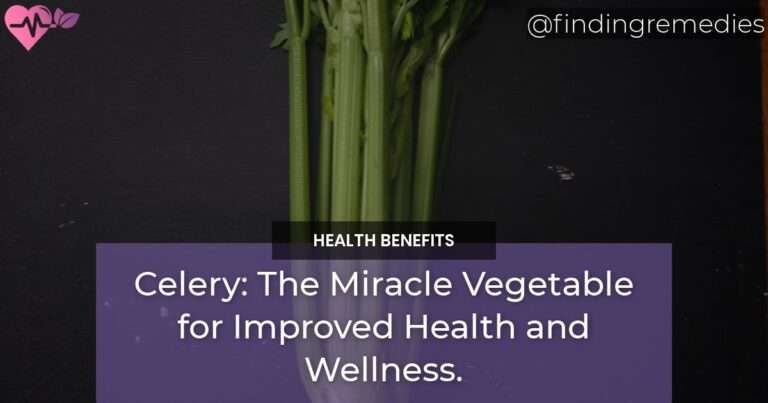Celery is a crunchy vegetable that belongs to the Apiaceae family. It is an incredibly healthy food that is packed with various nutrients, vitamins, and minerals that are essential for our bodies.
In this article, we will be discussing the nutrition profile, natural compounds, and health benefits of celery, along with its cooking techniques, storage, varieties, risk factors, and disadvantages.
Table of Contents
Nutrition Profile and Natural Compounds of Celery
Celery is low in calories and high in fiber, making it an excellent addition to a healthy diet. It also contains several essential vitamins and minerals, including:
- Potassium
- Folate
- Fiber
- Vitamin K
Celery also contains natural compounds that make it a healthy food option. Some of these natural compounds include:
- Flavonoids: These are antioxidants that protect our cells from damage caused by free radicals.
- Quercetin: This is a flavonoid that has anti-inflammatory properties.
Health Benefits of Celery
Celery’s Anti-Inflammatory Properties
Celery has anti-inflammatory properties due to the presence of flavonoids, including quercetin. These compounds help to reduce inflammation in the body, which can lead to several chronic diseases, including arthritis, cancer, and cardiovascular disease.
Celery’s Antioxidant Properties
Celery is rich in antioxidants, including flavonoids, which protect cells from damage caused by free radicals. This helps to reduce the risk of chronic diseases, including cancer and cardiovascular disease.
Celery’s Effects on Blood Pressure
Celery contains compounds that help to reduce blood pressure. These compounds work by relaxing the muscles in the walls of blood vessels, which makes it easier for blood to flow through them. This can help to reduce the risk of cardiovascular disease.
Celery’s Potential in Fighting Diseases
Celery has the potential to fight against several diseases, including cancer, due to its anti-inflammatory and antioxidant properties. It may also help to improve digestion and aid in weight loss due to its high fiber content.
Celery’s Nutritional Benefits for Skin and Bone Health
Celery is rich in vitamins and minerals that help to promote healthy skin and bone health. Vitamin K is essential for bone health, while folate and potassium are beneficial for skin health. Celery is also a great source of hydration and electrolytes, which are essential for maintaining healthy skin and bones.
Cooking, Storage, and Varieties of Celery
Proper Storage and Cooking Techniques for Celery
To store celery, wrap it in aluminum foil or plastic wrap and keep it in the refrigerator. Celery can be eaten raw or cooked. It can be steamed, boiled, stir-fried, or roasted.
Different Types of Celery and Their Nutritional Profiles
There are different varieties of celery available, including green, white, and red celery. Green celery is the most common and has a milder flavor. Red celery is sweeter and has a more intense flavor. White celery is less common and has a stronger flavor than green celery. All types of celery have similar nutritional profiles and health benefits.
Risk Factors and Disadvantages of Celery
Risks Associated with Eating Celery
Celery can cause allergic reactions in some people. It can also interact with certain medications, including blood thinners.
Negative Effects of Consuming Too Much Celery
Consuming too much celery can lead to digestive issues, including diarrhea, bloating, and gas. It can also cause skin irritation due to the presence of psoralens, which are compounds that make the skin sensitive to sunlight.
Conclusion
Celery is an incredibly healthy food that is rich in essential vitamins, minerals, and natural compounds. It has anti-inflammatory and antioxidant properties that help to reduce the risk of chronic diseases, including cancer and cardiovascular disease. Celery also has several nutritional benefits for skin and bone health and can aid in digestion and weight loss. By following proper storage and cooking techniques, celery can be a delicious addition to any diet.
Resources
- 1. “Potential health benefits of celery: A review of the evidence” by S. Anwar et al. (2019)
- 2. “Celery juice: Benefits, nutrition, and how to make it” by J. K. Ruiz (2019)
- 3. “In vitro and in vivo antioxidant properties of phenolics from Chinese celery (Apium graveolens L. var. dulce)” by L. Guo et al. (2012)

